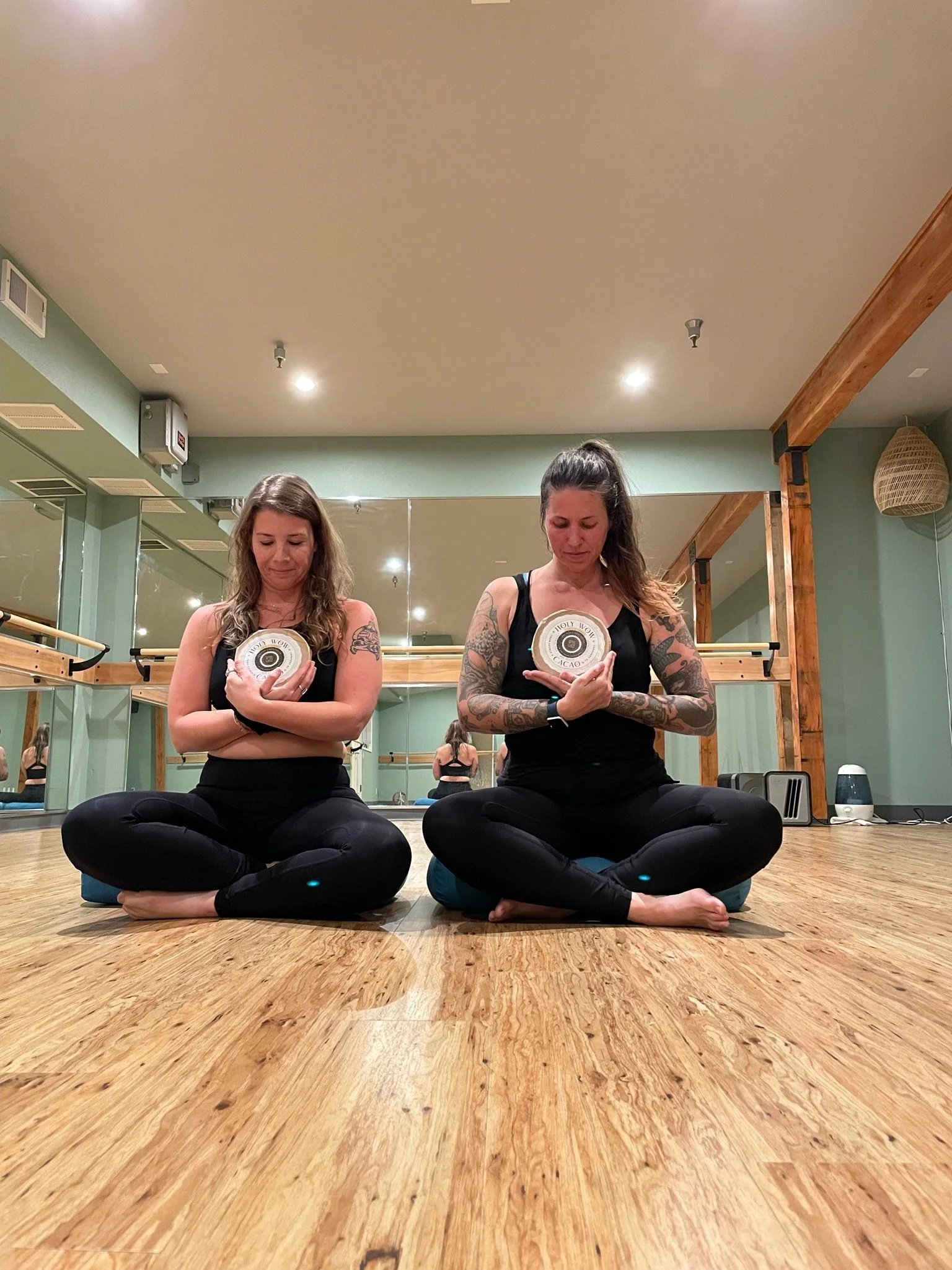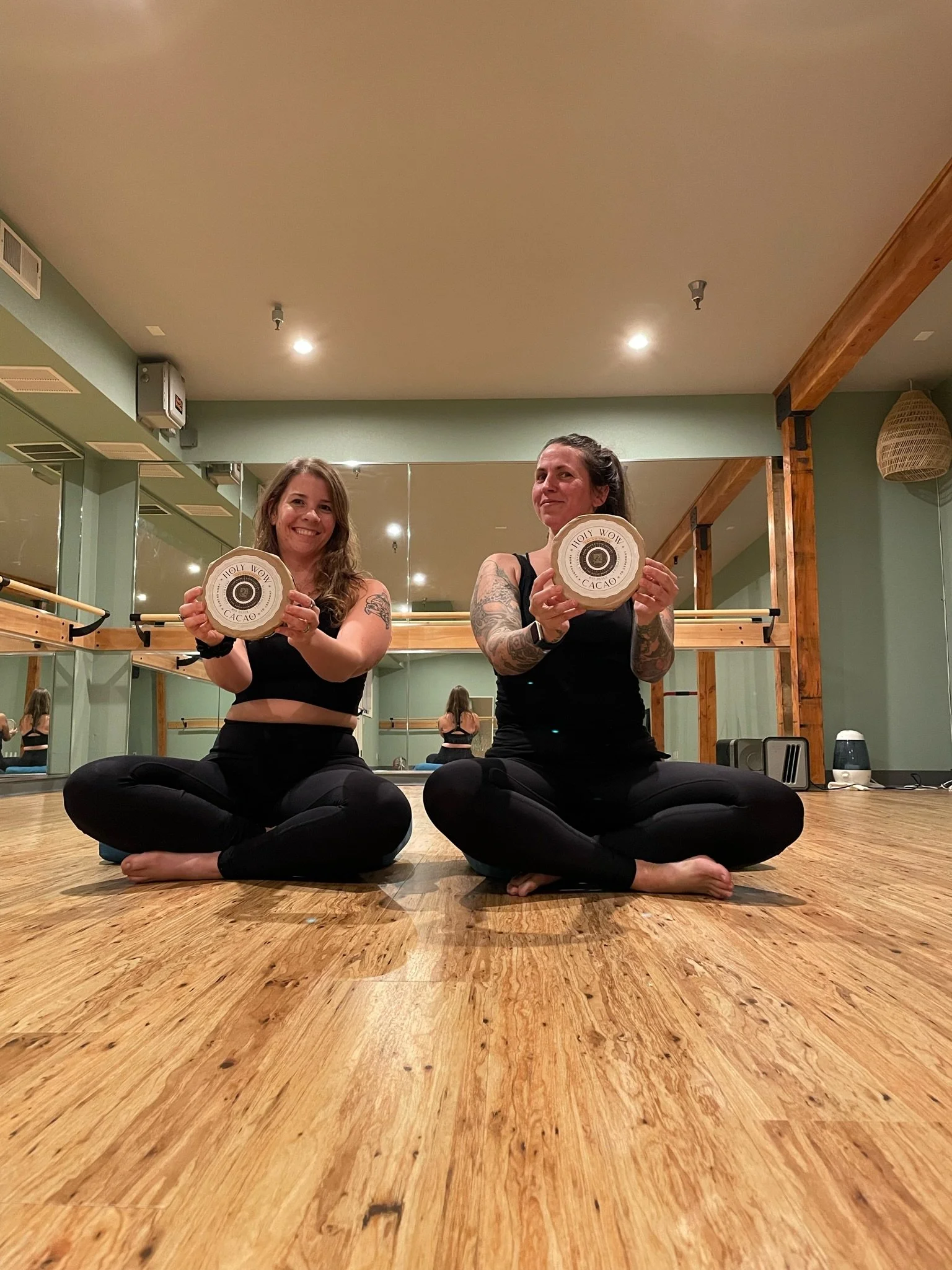What is the point of a Cacao Ceremony?
First things first, understanding and respecting the origins of Cacao Ceremonies:
Fig. 1. Left: Cylindrical vessel, 6th–9th century. Maya. Guatemala or Mexico, Mesoamerica. Ceramic; H. 7 7/8 x Diam. 6 1/4 in. (18.1 x 15.9 cm). The Metropolitan Museum of Art, New York, Anonymous Gift, 2005 (2005.435). Right: Vessel with seated lord, 7th–8th century. Maya. Mexico, Mesoamerica. Ceramic, stucco; H. 9 1/2 x Diam. 7 3/8 in. (24.1 x 18.8 cm). The Metropolitan Museum of Art, New York, Purchase, Joseph Pulitzer Bequest, 1992 (1992.4)
Cacao ceremonies have gained popularity in recent years, attracting spiritual seekers and chocolate enthusiasts alike. These unique rituals provide a sacred space for individuals to connect with themselves, others, and the spirit of the cacao plant. But where do these ceremonies originate, and what is their significance?
The origins of cacao ceremonies can be traced back centuries to the ancient civilizations of Mesoamerica, particularly the Mayans and the Aztecs. In these cultures, cacao held deep cultural, ceremonial, and spiritual significance. Cacao was considered a sacred gift from the gods, embodying divine energy and wisdom.
To honor the cacao plant and its magical properties, the Mayans and Aztecs conducted elaborate ceremonies with cacao as the focal point. These ceremonies were often conducted by spiritual leaders and shamans as a means of communing with the divine and accessing higher states of consciousness.
During a cacao ceremony, the cacao beans were ground into a fine paste and mixed with various herbs and spices. The resulting beverage, known as xocoatl, was thick and bitter, quite different from the sweet chocolate we know today. This drink was then shared among the participants, creating a communal and ceremonial bond.
Picture from: Mayan Ceremony (Cha-Chaac) (choco-storymexico.com)
The cacao ceremony was a time for introspection, healing, and connecting with the natural world. Through meditative practices, breathwork, and chanting, individuals sought to deepen their spiritual connection, release emotional blockages, and gain clarity of mind. The cacao plant was believed to act as a conduit for spiritual energy, opening the heart and facilitating inner exploration.
In addition to its spiritual significance, cacao was also used during important life events and social gatherings. It was a symbol of love, fertility, abundance, and vitality. Cacao was even offered as a sacred gift during exchanges between noble families or used as currency in trade.
What About now? What might I expect at a Cacao Ceremony today?
In modern times, cacao ceremonies have been revitalized as a way to reconnect with ancient wisdom and honor the sacred tradition. These gatherings have evolved to accommodate various spiritual practices, allowing individuals to experience the deep healing and transformative power of cacao in their own unique way.
Today's cacao ceremonies often incorporate elements such as meditation, chanting, sound healing, breath work, movement, and personal intentions. The focus is on creating a safe and nurturing space for participants to dive deeply into their inner realms, cultivate self-awareness, and connect with the loving energy of the cacao plant. You are likely to spend some time journaling, maybe sharing out your musings with other participates, and reflecting on your life and the current season you are in.
As the interest in mindfulness, holistic well-being, and ancient wisdom practices continues to grow, so does the popularity of cacao ceremonies. People are drawn to these rituals as a way to slow down, go inward, and experience a deeper sense of connection and embodiment.
Cacao ceremonies offer a journey into the heart and soul, a portal to divine communion and personal transformation. By tapping into the ancient wisdom of Mesoamerican cultures, cacao ceremonies provide a means for modern-day individuals to connect with their spiritual essence and experience the magic that lies within the cacao plant.
HOw is the cacao sourced? What makes it special?
The best Ceremonial Cacao comes from the heirloom Criollo bean – a native species of Cacao. Most importantly, it is organically and sustainably grown where local indigenous growers and communities are supported, ethically and generously.
This cacao doesn’t taste quite like the chocolate blocks you may be used to! It is quite rich and can be slightly bitter as it isn’t sweetened in any way.
Erin Quinn and Danielle Arias at Studio 36OM in Silverdale WA. Cacao is sourced from Holy Wow Cacao. This 100% Guatemalan Cacao is sourced from family farmers with deep-rooted practices of reciprocal land stewardship.
How might a Cacao Ceremony benefit me?
Ceremonial cacao contains incredible beneficial properties . This is why cacao is known to the Ancient Mayan and Aztec culture as the ‘Food of the Gods’. It’s no wonder that since 1900 B.C. Ceremonies were conducted (in the ancient Mayan and Aztec civilizations) by ancient shamans, to prepare for or be propelled into journeys. Cacao contains anandamide, a neurotransmitter produced in the brain that binds to the THC receptors. It’s also known as the “bliss molecule” (named after “ananda”, the Sanskrit word for “bliss.”). Cacao is high in antioxidants, iron, magnesium, calcium, and more. There's also research showing regular consumption of cacao can improve heart heatlh.
heart opening
Within its silky depths lies theobromine, a natural compound that has captivated hearts for centuries. Originating from the Greek words "theo" (meaning god) and "broma" (meaning food), theobromine is aptly named the "food of the gods." Found in abundance within the cacao bean, theobromine gently stimulates the heart, lending a sense of warmth and well-being.
intention of the ceremony
The goal is to communally uplift mood, increase vitality, and open the heart and intuition, along with other personal spiritual intentions. They are a group activity shared within a sacred space, and their communal nature amplifies the elements involved. You will likely feel a heightened sense of unity, consciousness or simply a deeper connection to yourself and the world around you.
mood-boosting, community connection: the magic of the ritual
Let’s paint a picture…as you take a seat among a small gathering of individuals, the atmosphere becomes charged with anticipation and positive energy.
The ceremony begins with a brief meditation, allowing you to ground yourself and leave behind the worries of the outside world. You are encouraged to set an intention, perhaps vocalizing what you hope to gain from this experience. Whether it's finding inner peace, cultivating gratitude, or simply embracing more joy, your intention becomes the guiding light throughout the ceremony. The facilitators, knowledgeable guides with reverence for the sacred cacao plant, explain the unique properties and benefits of cacao.
With the sound of soft music playing in the background, each participant is presented with a warm cup of pure cacao elixir. You cradle the cup in your hands, appreciating its comforting warmth and sweet aroma. As you slowly sip the cacao, its velvety texture and distinct flavor envelop your taste buds, awakening your senses and signaling the beginning of an inner voyage.
Guided by the facilitator, you are invited to dive deeper into yourself, exploring the layers of your emotions and desires. Meditative exercises, sometimes gentle movement, and healing chants accompany the ceremonial experience, assisting the cacao in its transformational work. The cacao acts as an ally, melting away any tensions or stagnant energy, and providing a safe container for emotional release and self-discovery.
As the cacao takes effect, a palpable shift occurs within the space. Hearts begin to open, smiles grace the faces of participants, and a collective wave of joy washes over the room. You find yourself connecting with others on a profound level, forming a sense of community and belonging. The cacao ceremony encourages vulnerability and authenticity, allowing for emotional healing and personal growth.
With the ceremony coming to a close, reflections and gratitude are shared among the group, reminding everyone of the beauty of this shared experience. The energy in the room remains vibrant and uplifting, as the effects of the cacao continue to permeate throughout the day. Buoyed by a renewed sense of joy, serenity, and connection, you leave the ceremony feeling nourished, revitalized, and ready to embrace life's adventures with a newfound enthusiasm.
In a world filled with demands and stress, a mood boosting cacao ceremony is a gentle reminder to slow down, take a breath, and reconnect with yourself and others. This immersive experience invites you to prioritize self-care, fostering a sense of well-being and inner balance. So, indulge in the sacred delights of cacao, and let its transformative magic spark joy and serenity in every aspect of your life.
How to prepare for a Cacao Ceremony
Come with an open/beginner’s mind - Cacao ceremonies do different things for different people.
Turn off your phone, do not bring your phone or apple watch or any electronics into the ceremony.
Come with a very light stomach or an empty stomach. If you are new to a cacao ceremony, prepare by eating something very light. For those that are used to fasting and cleansing, come with an empty stomach. Cacao is very filling so drinking and eating cacao will start to stimulate your nervous system.
Dress comfortably because you’ll be sitting and/or lying down.
The cacao will be somewhat bitter, there is no sugar and it is prepared with water and sometimes some spices (so appropriate for those who do not partake in dairy). The typical serving size is 3 oz or a little more. It is not recommended to have a heaping mug of cacao, and honestly if you pour that much you will not be able to finish it.
During the ceremony, if you feel like sound bath is too intense, or you don’t feel like laying down and want to sit up or even move that is perfectly fine. There is no one right way to receive in ceremony.
Cacao ceremonies can last anywhere from 1 to 2 hours depending on who is leading it.
Be ready for heart opening and eventually a greater awareness of yourself and who you were really meant to be.
Last but not least, contradictions: While cacao is most definitely stimulating, it's not considered a psychedelic. The FDA classifies cacao as "generally regarded as safe”, and its effects are fairly mild, even in the higher doses that you might drink in a ceremony. It is completely legal to purchase, and shouldn't cause any adverse side effects (though those who are on antidepressants, particularly MAOIs and some SSRIs, will want to talk to their doctor before trying it).




